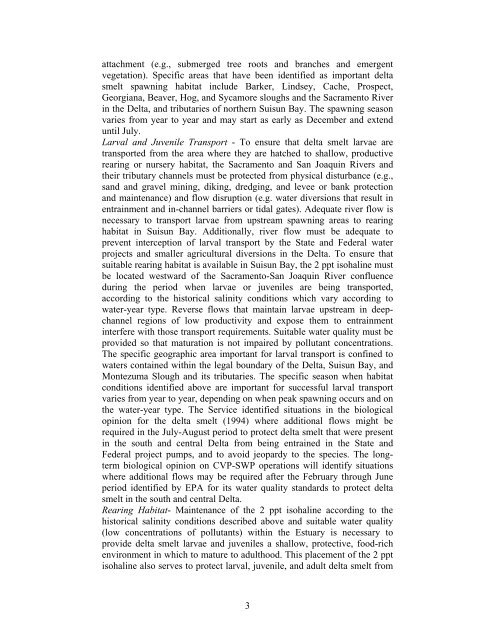ESWR page - Endangered Species & Wetlands Report
ESWR page - Endangered Species & Wetlands Report
ESWR page - Endangered Species & Wetlands Report
Create successful ePaper yourself
Turn your PDF publications into a flip-book with our unique Google optimized e-Paper software.
attachment (e.g., submerged tree roots and branches and emergent<br />
vegetation). Specific areas that have been identified as important delta<br />
smelt spawning habitat include Barker, Lindsey, Cache, Prospect,<br />
Georgiana, Beaver, Hog, and Sycamore sloughs and the Sacramento River<br />
in the Delta, and tributaries of northern Suisun Bay. The spawning season<br />
varies from year to year and may start as early as December and extend<br />
until July.<br />
Larval and Juvenile Transport - To ensure that delta smelt larvae are<br />
transported from the area where they are hatched to shallow, productive<br />
rearing or nursery habitat, the Sacramento and San Joaquin Rivers and<br />
their tributary channels must be protected from physical disturbance (e.g.,<br />
sand and gravel mining, diking, dredging, and levee or bank protection<br />
and maintenance) and flow disruption (e.g. water diversions that result in<br />
entrainment and in-channel barriers or tidal gates). Adequate river flow is<br />
necessary to transport larvae from upstream spawning areas to rearing<br />
habitat in Suisun Bay. Additionally, river flow must be adequate to<br />
prevent interception of larval transport by the State and Federal water<br />
projects and smaller agricultural diversions in the Delta. To ensure that<br />
suitable rearing habitat is available in Suisun Bay, the 2 ppt isohaline must<br />
be located westward of the Sacramento-San Joaquin River confluence<br />
during the period when larvae or juveniles are being transported,<br />
according to the historical salinity conditions which vary according to<br />
water-year type. Reverse flows that maintain larvae upstream in deepchannel<br />
regions of low productivity and expose them to entrainment<br />
interfere with those transport requirements. Suitable water quality must be<br />
provided so that maturation is not impaired by pollutant concentrations.<br />
The specific geographic area important for larval transport is confined to<br />
waters contained within the legal boundary of the Delta, Suisun Bay, and<br />
Montezuma Slough and its tributaries. The specific season when habitat<br />
conditions identified above are important for successful larval transport<br />
varies from year to year, depending on when peak spawning occurs and on<br />
the water-year type. The Service identified situations in the biological<br />
opinion for the delta smelt (1994) where additional flows might be<br />
required in the July-August period to protect delta smelt that were present<br />
in the south and central Delta from being entrained in the State and<br />
Federal project pumps, and to avoid jeopardy to the species. The longterm<br />
biological opinion on CVP-SWP operations will identify situations<br />
where additional flows may be required after the February through June<br />
period identified by EPA for its water quality standards to protect delta<br />
smelt in the south and central Delta.<br />
Rearing Habitat- Maintenance of the 2 ppt isohaline according to the<br />
historical salinity conditions described above and suitable water quality<br />
(low concentrations of pollutants) within the Estuary is necessary to<br />
provide delta smelt larvae and juveniles a shallow, protective, food-rich<br />
environment in which to mature to adulthood. This placement of the 2 ppt<br />
isohaline also serves to protect larval, juvenile, and adult delta smelt from<br />
3
















